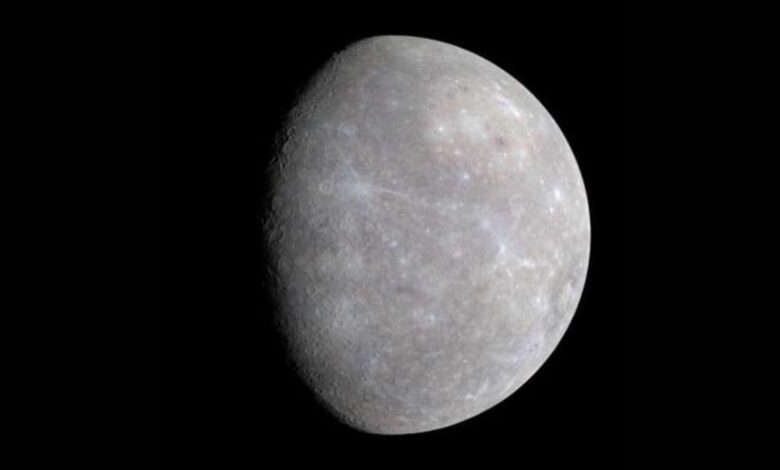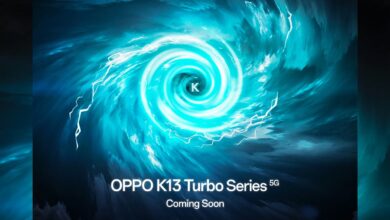Lithium Discovered in Mercury’s Exosphere: Magnetic Wave Study

Groundbreaking Discovery: Lithium Detected in Mercury’s Exosphere
For the first time ever, scientists have successfully detected lithium in the exosphere of Mercury using a novel technique based on magnetic-wave analysis. This significant finding, published in Nature Communications, marks the first confirmed presence of lithium around the smallest planet in our solar system. Unlike thicker atmospheres, Mercury’s thin exosphere poses challenges for direct detection methods. This innovative approach bypasses those limitations by analyzing pick-up ion cyclotron waves.
Unveiling Lithium’s Electromagnetic Fingerprint
Instead of directly searching for lithium atoms, researchers focused on identifying the electromagnetic “fingerprint” left behind when solar wind interacts with freshly ionized lithium. These faint signals, known as pick-up ion cyclotron waves, provided the crucial evidence needed to confirm the long-suspected presence of lithium in Mercury’s exosphere. The detection of these waves represents a major advancement in our ability to study the composition of tenuous atmospheres.
How Magnetic Waves Reveal Lithium
The process involves several key steps:
- Solar Wind Interaction: The solar wind, a stream of charged particles from the sun, interacts with lithium atoms in Mercury’s exosphere.
- Ionization: Solar ultraviolet radiation ionizes the lithium atoms, creating lithium ions.
- Electromagnetic Instabilities: These ions are swept into space by temporary lithium wind, which increases the speed of the formation of electromagnetic instabilities.
- Cyclotron Waves: These perturbations induce oscillations at a specific cyclotron frequency, which is determined by the mass and charge of lithium.
- Indirect Identification: By measuring this frequency, scientists can indirectly identify the presence of lithium.
MESSENGER Data: A Treasure Trove of Information
The research team, led by Daniel Schmid from the Austrian Academy of Sciences, meticulously analyzed four years of magnetic field data collected by NASA’s MESSENGER spacecraft. Within this vast dataset, they identified twelve short-lived events, each lasting only a few minutes, that exhibited the characteristic lithium-specific wave signatures. This painstaking analysis highlights the value of long-term space missions and the wealth of data they provide.
Meteoroid Impacts: A Source of Lithium?
Lithium has proven difficult to detect directly due to its scarcity and dispersed nature. Traditional particle detectors on previous missions, such as Mariner 10 and MESSENGER, were unable to capture it. The most plausible explanation for the presence of lithium in Mercury’s exosphere is meteoroid impacts.
The Role of Meteoroid Bombardment
Mercury’s surface is constantly bombarded by meteoroids. These high-speed collisions can vaporize significant amounts of material, including volatile elements like lithium, and eject them into the exosphere. A related study suggests that the detected events are linked to meteoroid strikes by objects with radii of 13-21 centimeters. These impacts can vaporize up to 150 times their own mass, enriching the atmosphere with volatiles.
| Feature | Description | Significance |
|---|---|---|
| Meteoroid Impacts | Constant bombardment of Mercury’s surface | Source of volatile elements like lithium |
| Vaporization | High-speed collisions vaporize material | Releases lithium into the exosphere |
| Exosphere Enrichment | Atmosphere becomes enriched with volatiles | Facilitates detection through magnetic waves |
Implications for Understanding Planetary Evolution
Schmid’s study suggests that similar processes could be responsible for the retention or acquisition of volatile elements in other airless bodies throughout the solar system. This finding has profound implications for our understanding of the geochemical history of Mercury and opens new avenues for exosphere exploration. By studying the composition of these tenuous atmospheres, we can gain valuable insights into the formation and evolution of planets.
Future Directions
This groundbreaking research paves the way for future studies aimed at further characterizing the composition of Mercury’s exosphere and understanding the processes that govern its dynamics. Future missions equipped with advanced instruments could provide even more detailed information about the distribution and behavior of lithium and other volatile elements, shedding light on the complex interplay between surface, atmosphere, and space environment.




